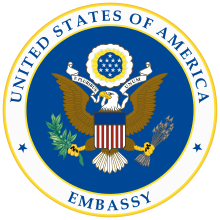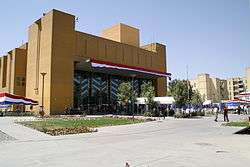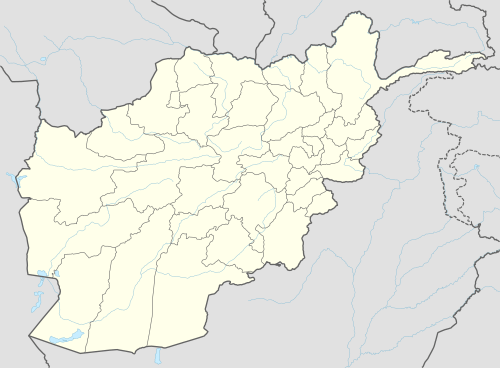Embassy of the United States, Kabul
The Embassy of the United States of America in Kabul is the diplomatic mission of the United States of America in the Islamic Republic of Afghanistan. The embassy complex is located on Great Massoud Road in the Wazir Akbar Khan neighborhood of the Afghan capital, Kabul, and is home to the U.S. Ambassador to Afghanistan. The Embassies of Finland and South Korea are located behind this complex and the headquarters of NATO's Resolute Support Mission is located across the street.
| Embassy of the United States, Kabul | |
|---|---|
| Native name Pashto: د امریکا متحده ایالاتو لوی سفارت- کابل | |
  Chancery Building as seen from its plaza | |
| Location | |
| Coordinates | 34.534722°N 69.19°E |
| Established | 1942 |
| Ambassador | Vacant (since January 6, 2020)[1][2] |
 Location of Embassy of the United States, Kabul in Afghanistan | |
History
The U.S. Embassy in Kabul was elevated in May 1948 from the U.S. Kabul Legation. Louis Goethe Dreyfus, who previously served as Minister Plenipotentiary from 1940 to 1942, became the U.S. Ambassador to Afghanistan from 1949 to 1951.[3] It was closed in 1989, before the start of the long civil war followed by the Taliban takeover. The embassy re-opened after the US-led Operation Enduring Freedom in late 2001 and was under construction until early 2006, when U.S. President George W. Bush along with Afghan President Hamid Karzai held an inauguration ceremony. The U.S. State Department is spending another $500 million to further expand its premises, which was scheduled to be completed in 2014.[4] However, the U.S. State Department extended the completion date to July 2016.[5]
Operation Enduring Freedom
During the very early phases of Operation Enduring Freedom, a small detachment of US Marines from Kilo Battery 3rd Battalion 10th Marines attached to the 26 MEU, who specialized in Embassy Reinforcement was tasked with retaking the U.S. Embassy in Kabul in early December 2001. This Marine Unit was part of the one of the longest amphibious operation in Marine Corp History starting the assault from LCAC's into Pakistan then moving on to Bagram Airfield before the Airfield was fully secured by US and Coalition troops. The Marines set up camp inside of a factory building and secured local transportation in the form Afghan private buses driven by Marines to disguise their pending assault on the Embassy. They left in the early morning and wore their issued cold weather black fleece Jacket over their gear and opted for Boonie hats and watch caps instead of the PASGT helmets to further disguise their assault. The Marines secured and held the war-torn US Embassy until Department of State Security (DOD/DOSS) arrived to properly handle the sensitive information that was still locked in the Embassy and to measures the compound's suitability for a continued U.S. presence on the site. The Marines under Hard Cover inside the Embassy wore their full gear in preparation for counterattacks, On the outside it was a different story and the two Marines at the Observation Post (OP) located at the old gatehouse beyond the protection of the Security wall still wore the low profile Uniform that was used during the assault on the Embassy with the addition of flannel shirts. They held that OP till the Marines could secure the building and fortify shooting positions on the corners of the embassy's roof. This OP would only be used during daylight hours after this point to turn away everyone trying to gain entry to the Embassy. Later that month, The Marines from this Unit were the first Marines to raise the US Flag since the embassy was closed in 1989. This was the same flag that had flown over the U.S. Embassy in Kabul that day when it closed in 1989.
September 2011 attack
Heavily armed Taliban insurgents wearing suicide vests struck various buildings in Kabul on 13 September 2011, and at least 7 people were killed and 19 wounded. The U.S. embassy was among the buildings targeted and several Afghan visa applicants who were waiting at the embassy were wounded. No embassy personnel were hurt in the incident.[6][7] The United States blamed the Pakistani Army and its Inter-Services Intelligence (ISI) spy network for the attack.[8][9] Another deadly attack at an annex to the embassy occurred later the same month.[10]
April 2012 attack
As part of a nationwide series of coordinated attacks, Taliban elements attacked the embassy on April 15, 2012. The attack was defeated by Afghan security forces. Gen John Allen, commander of the International Security Assistance Force, stated he was "enormously proud" of the response mounted by Afghan security forces. He added: "No one is underestimating the seriousness of the attacks, and we'll work hard to determine the circumstances that led to today's events." [11]
September 2019 attack
On September 11, 2019 A rocket exploded at the embassy, marking an attack on the 18th anniversary of the September 11 attacks.[12]
Other events
On November 30, 2015 the embassy issued a public warning of an imminent terrorist attack in Kabul. The warning was based on credible intelligence saying the attacks would take place in two days. The embassy spokeswoman told reporters that the American citizens, interests, or the embassy were not specifically threatened.[13]
See also
- Afghanistan – United States relations
- Afghan American
- Embassy of Afghanistan, Washington, D.C.
- United States Ambassador to Afghanistan
References
- https://www.cnn.com/2020/01/06/politics/john-bass-departs-afghanistan/index.html
- https://thehill.com/policy/international/middle-east-north-africa/476993-us-ambassador-to-afghanistan-leaving-post-in
- "About the Embassy". U.S. Embassy in Kabul. Archived from the original on 2011-10-15. Retrieved 2011-10-13.
- "U.S. To Spend $500 Million On Kabul Embassy". Radio Free Europe/Radio Liberty (RFE/RL). November 4, 2010. Retrieved 2011-01-18.
- "Kabul Embassy Construction Costs Have Increased and Schedules Have Been Extended". GAO. July 8, 2014. Retrieved November 9, 2014.
- Holehouse, Matthew (13 Sep 2011). "Kabul US embassy attack: September 13 as it happened". telegraph.co.uk.
- RUBIN, ALISSA (14 Sep 2011). "U.S. Embassy and NATO Headquarters Attacked in Kabul". [].
- "U.S. blames Pakistan agency in Kabul attack". Reuters. September 22, 2011. Archived from the original on September 25, 2011. Retrieved September 22, 2011.
- "Clinton Presses Pakistan to Help Fight Haqqani Insurgent Group". Fox News. September 18, 2011. Retrieved September 21, 2011.
- NYT: September 26, 2011, attack
- Taliban launches largest attack on Kabul in 11 years. The Guardian.
- Anna, Cara (2019-09-10). "Rocket blast at US Embassy in Kabul on 9/11 anniversary". AP NEWS. Retrieved 2019-09-11.
- "U.S. Embassy warns of imminent attack in Kabul". Reuters. 2015-11-30. Retrieved 2015-11-30.
External links
| Wikimedia Commons has media related to Embassy of the United States in Kabul. |